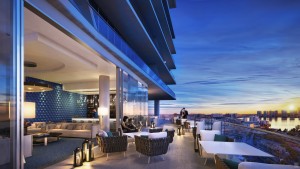Dan Riordan, president of residential development at Turnberry Associates, moved from Chicago to Miami during the Miami Vice era. After leaving South Florida twice for Turnberry assignments, he has witnessed Miami grow up while maintaining its allure.
Now, he considers Aventura and Sunny Isles Beach to be the “bullseye” for high-end, oceanfront buildings in South Florida, as he oversees the development of Turnberry’s latest proposed tower.
Turnberry’s developments in Miami-Dade span from Aventura Mall to the Fontainebleau Miami Beach, and most recently include a joint partnership with Richard LeFrak to develop Biscayne Landing.
TRD sat down with Riordan and discussed his start in the business, how Miami has changed and who Turnberry Ocean Club, the company’s preconstruction residential tower in Sunny Isles Beach, is targeting.
How did you get into real estate?
I’ve been doing this for 27 years and I’ve been with two developers. I was sitting in Chicago, and it was 20 degrees below zero, watching Don Johnson drive a Ferrari, with his sun tan and Ray-Bans. Of course, I was in my early 20s. I had just gotten out of college and I was selling computers. I came down to visit my brother, who was in development in Boca Raton. I lined up some interviews and that was it.
I started at a development called Fisher Island in 1986. Miami was a whole different place back then. There was no South Beach. It was a little dicey, but it was pretty cool. It was a tough time to be doing a development in Miami because no one was coming down. It was all Boca, Palm Beach — nothing in the Grove, pre-South Beach. It’s always an interesting time to be in Miami.
When I joined Turnberry, I moved to Las Vegas. Back in 1998, I started as a salesman for them. I moved my family out there. Most people thought I was semi-crazy to do that.

Rendering of the Turnberry Ocean Club sunset bar lounge (credit: ArX Solutions)
What makes Turnberry Ocean Club different from other Turnberry developments?
This is a single tower site, so we were challenged to raise the bar. Working with Carlos Zapata, we came up with the sky club idea, where we also are including some of the traditional kinds of amenities — the pool, a daytime restaurant, a pool bar, a restaurant for dinner. Our residents are used to having some kind of food and beverage.
There will be a three-story lobby [with below-ground parking] where you look right through to the ocean, which isn’t that common. A lot of developers in the past have done above-ground parking, so when you walk in you have to take an elevator to get to the lobby. It’s less expensive to build parking above ground then below ground because of how close we are to the water table.
We have 154 overall residences, 10 of which are really kind of special, larger and more unique. Most of these collection residences are multilevel. We have five duplexes with their own pools, and triplexes with bigger pools — 20 feet by 60 feet.
We start at around $4 million. The duplexes are in the $20 million to $35 million range. We look to start construction this year and complete it in 2018.
[vision_pullquote style=”3″ align=””] “People have gotten more demanding. These [developments] cost a lot more to build. They’re selling at higher prices. People’s expectations are different. We’ve tried to keep up with that.” [/vision_pullquote]Who’s buying?
A lot of Latin American, Canadian, European and the Northeast. I remember when they started direct flights to Europe and what kind of effect it had. Next, it’ll be China. The Middle East is opening up now.
Are these second or third homes?
Mostly second homes. A third of residents will live here full-time. Some will use it for vacation homes.
Who are you targeting?
Our typical buyer is an end user, versus a lot of investors who come to the Miami market from up north and overseas. We’re not looking for investors, so we intentionally stayed away from the one and two-bedrooms. We launched sales at the end of October. We’re probably at around 25 percent of the way there.
A lot of these people from Europe and South America aren’t used to the air conditioning. We have a pool on the ocean side and the bay side on the 30th floor, so you can get sun almost any time of the day. There’s a bar area; there’s an outdoor sky theater. We have ladies’ and men’s locker rooms with saunas, a yoga and a Pilates studio on the 31st floor, an indoor fitness center and an outdoor fitness center, which I haven’t heard of anyone do. We put a spa on the west side, so the fitness, yoga and Pilates face the ocean. The 32nd floor is where we get into the more social [component]. There will be an indoor bar and an outdoor bar.
There’s about 70,000 square feet of amenities in the building, almost 40,000 of those are in the sky club section. We don’t know another building in Miami or New York City where a developer has taken out four floors to make this happen. So that’s an opportunity cost.
Why take the opportunity cost?
People have gotten more demanding. These [developments] cost a lot more to build. They’re selling at higher prices. People’s expectations are different. We’ve tried to keep up with that.
Now, lifestyle really starts with architecture. Years ago, most of the buildings were OK. We weren’t going to do what we’ve always done.
There are a lot of developers teaming up with hotel brands and fashion designers. There’s guys that are more expensive, but they’re not nicer.
We’ve worked 50 years to create a brand of our own. Forget about what it’s called — it’s about the experience you’re going to get.
This interview has been edited and condensed for clarity.
